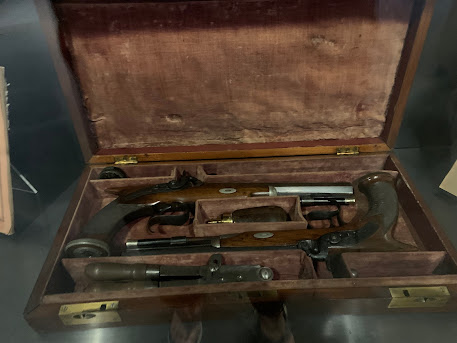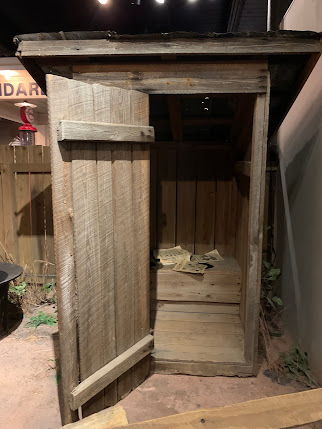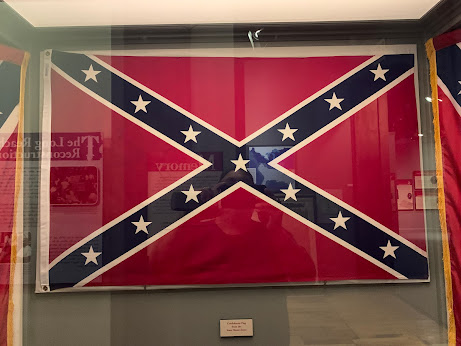We had never been to this museum before so decided to make a stop.
This museum is dedicated to the history of South Carolina and has four floors of permanent and changing exhibits. It is the largest museum in the state, and is a Smithsonian Affiliate. Positioned on an old shipping canal that dates back to pre-Civil War times, it is widely recognized as a resource for South Carolina history and lifestyle. The museum opened in 1988 and is housed in what it calls its largest artifact, the former Columbia Mills Building which was listed on the National Register of Historic Places in 1982. When the mill opened in 1894, manufacturing cotton duck cloth (a canvas-like material), it was the first completely electric mill in the world.
It was huge and our time was limited so we spent most of our time viewing Civil War era exhibits. My 2x great grandfather served for South Carolina in the Civil War (more on that later) so I hoped I might see something about him or his military service. Unfortunately, it didn't happen. But we did see some interesting exhibits.
There's some history in this desk.
Carriages were made in South Carolina, but wealthy planters often preferred Northern ones. When John L. Manning of Sumter County wanted transportation befitting the splendor of his new home, Milford Plantation, he bought this carriage made by Collis and Lawrence in New Haven, Connecticut.
Frederick Douglass came to South Carolina for the first time in early March, 1888. A Black militia unit calling themselves the Douglass Light Infantry welcomed him to the city. They escorted their namesake to Mt. Zion AME Church and presented him with this walking stock. It is engraved with his name, their company's initials, the date, and strawberries, which is a symbol of righteousness. The trip had a strong impact on Douglass.
When the first State House was finished in Charleston in 1758, a chair for the royal governor was ordered from Thomas Hutchinson and Thomas Elfe, local cabinetmakers. The governor used it when he presided over the Royal Council, the upper body of the legislature.
The chair was given to University of South Carolina library in 1856 by William C. Preston, a former U.S. Senator from South Carolina and a former president of the school. No one knows where the chair was from 1776 to 1856 or how or when Preston got it but recent research has authenticated it.
This outhouse came from the Tabernacle Methodist Church in Spartanburg County. It replaced an earlier outhouse in the 1940s and was removed in 1982 when plumbing was installed in the church. The Rev. Benjamin Wofford, founder of Wofford College, worshipped at this church in the late 1700s as a youth.
The outhouse got its name from its location in regards to the main building. At least 20 yards was a safe distance from one's house and water supply. Bitter cold or extreme heat could make a trip to the outhouse very uncomfortable. (no kidding!)
Toilet paper was almost unheard of in the 1800s. Efforts to introduce individual sheets of toilet paper as early as 1857 failed because it was more economical to use old newspapers, and later, large mail order catalogs.
This pitcher commemorated a new monument to the Washington Light Infantry's Civil War service erected in 1891. Confederate memorials across the South celebrated wartime victories and sacrifices, but obscured the service of black soldiers and the cause of the conflict.
In March, 1962 to commemorate the Civil War centennial, the South Carolina General Assembly agreed to fly a version of the Confederate Battle Flag on the dome of the Statehouse. The House and Senate placed the flag in their chambers in 1938 and 1956 respectively.
In the 1970s, the flags began to draw strong criticism. Over the next 20 years, groups of supporters and protestors debated the fate of the flag. In 2000, the General Assembly voted on a compromise. They ordered the flags to be removed from the dome and chambers and "placed permanently on display in a suitable location in the State Museum." The compromise also ordered the smaller, Confederate battle standard raised at the Confederate soldier monument in front of the statehouse.
Calls continued to remove the flag from statehouse grounds completely and a tragic event in Charleston brought the discussion front and center. On June 17, 2015, a white supremacist murdered nine worshippers at "Mother" Emanuel A.M.E. Church after posting images on social media prominently displaying the Confederate flag. In the grief that followed, Gov. Nikki Haley called for legislators to pass a bill removing the flag. After weeks of debate, the Assembly voted to remove the flag.
About 8,000 people gathered on statehouse grounds on July 10. 2015 to witness the South Carolina Highway Patrol Honor Guard take down the flag from behind the Confederate memorial. They presented the flag to the South Carolina Relic Room and Military Museum where it is now on display.









Can you imagine wiping yourself with newspaper?? YUCK
ReplyDeleteOr a leaf?
DeleteOr nothing!!!
ReplyDeleteNever in my life did I think this post would turn into alternatives to toilet paper. LOL!
DeleteLOL! I guess our minds are in the toilet, as they say....
Delete